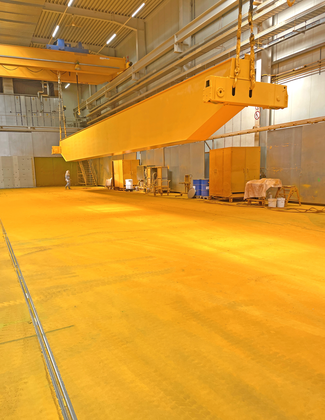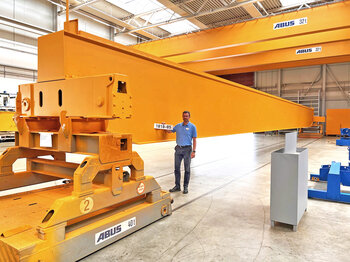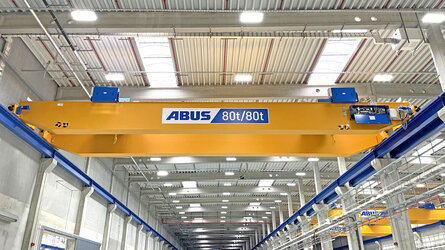Efficiency at a new level: 191 overhead travelling cranes in operation at KraussMaffei
It is not often that a company gives up its existing headquarters and builds a completely new one a few kilometres outside the city on the proverbial "greenfield site". Especially not when it is the headquarters of a technology leader. But that is exactly what KraussMaffei Technologies GmbH has done. And for the new location in Parsdorf, east of Munich, the company ordered no fewer than 106 overhead travelling cranes and 25 jib cranes and HB light crane systems from us, ABUS Kransysteme GmbH. We accompanied one of the overhead travelling cranes from the delivery of the material to the installation of the finished crane in the Parsdorf factory. Delivery and steel construction were completed in the first part of this series, now it's on to the next production steps.
How the cranes are given the right "coat of paint"
ABUS's "favourite colour" is immediately recognisable when you enter the painting area in the production facility in Gummersbach-Herreshagen. The vast majority of the cranes manufactured here leave the production line in RAL 1007 "daffodil yellow". The size of the product alone - ABUS manufactures cranes with a span of up to 45 metres and a web plate height of 3 metres - means that manual painting of the crane girders is still the most efficient method of coating the welded and assembled crane girders.
Two painters apply the paint to the steel using the airbrush method. They work in a single-coat process. This means that there is neither a primer nor a second top coat. The special acrylic paint combines all the requirements for substrate adhesion, corrosion protection and durability in a single pass. This is not just about the colour shade: the lacquer plays a major role in ensuring the corrosion resistance of the box girder and, depending on the version, even allows it to be used outdoors.
Thanks to the solvent-free water base of the paint, our company complies with all solvent emission regulations, despite the large amount of paint required due to the dimensions of the crane. For this reason, and thanks to the elaborate ventilation system in the area, odour pollution remains at a minimum here and in the adjacent production areas.
The subsequent drying time is also particularly important. In order to be able to continue with the assembly of the crane in a timely manner, the paint is designed in such a way that it is already dry enough after three hours to allow for the subsequent steps in assembly. These take place directly in the adjacent production facility - the electrical equipment of the crane is installed.
The heart of the crane
This is where the yellow box girder finally becomes a fully functional overhead travelling crane with all its additional functions. In the first step, the wire rope hoist is placed on the bridge rails. Parallel to the box girder, it was welded, painted and fitted with the hoist rope in an adjacent facility in Gummersbach. This is followed by the assembly of the control system, the travel drives and the power supply. Like almost all other ABUS cranes, the wire rope hoist for the 80-tonne crane for Krauss Maffei is supplied with power by an energy chain. With this system, a folding plastic chain with internal cables is pulled back and forth as the crab unit moves.
All electrical equipment is now mounted, connected and configured. As with the steel construction before, ABUS also relies on an efficient configuration of the crane for the electrical system. All equipment details were specified in advance and compiled using an in-house configurator. The associated circuit diagrams and also the programming of the control components are compiled automatically. This minimises the manual work involved in the electrical design of the crane, making it quick and cost-effective.
The 191 crane systems for KraussMaffei prove that, thanks to the wide range of configurations, all customer requirements can be met. Depending on the subsequent production area in the Parsdorf plant, they are equipped with a wide variety of technologies to provide the best possible support for production. Some of the cranes are equipped with state-of-the-art control technology, offered by ABUS under the term "ABUControl". Here, numerous control settings of the crane can be set and adjusted via WiFi and tablet using the "KranOS" interface. Other cranes at KraussMaffei are equipped with the contactor control system that has been established for decades and is robust under all circumstances. Frequency converter-controlled cranes from the "ABULiner" series are also included within the scope of supply. Most of the cranes for KraussMaffei are controlled by radio remote control. Depending on the application scenario, the planners opted for the handy ABURemote Button transmitter or the ABURemote Joystick radio remote control. Calibrated hook blocks were also part of the order, as well as cranes with two crab units that can lift a load together and turn it at the same time, an impressive application given the maximum load capacity of 80 tonnes.
After complete assembly, electronic configuration and extensive testing, the next step is to prepare for transport. Due to the dimensions alone, this has to be done in disassembled form - the overhead travelling crane is therefore dismantled again and prepared for onward transport to site.


